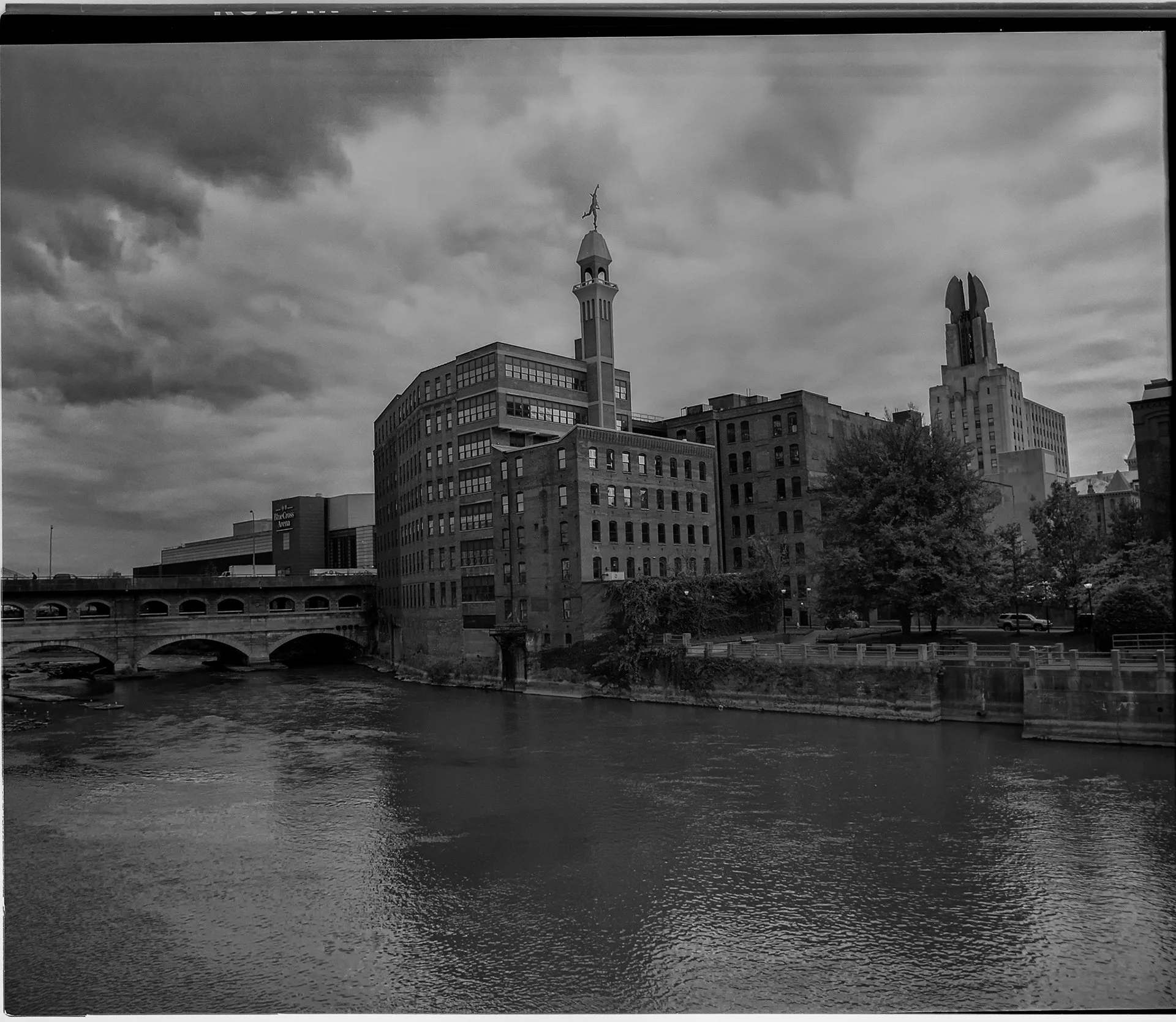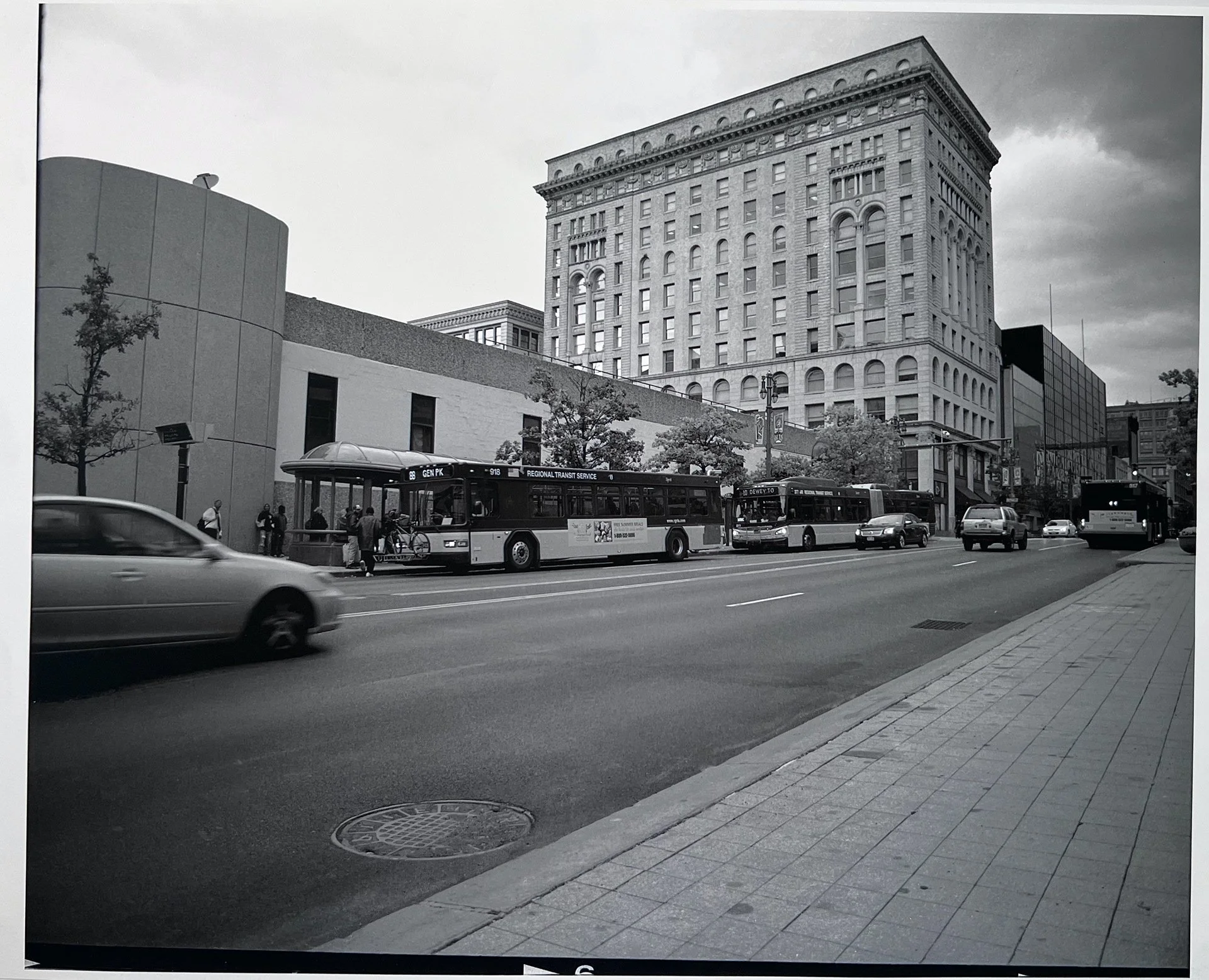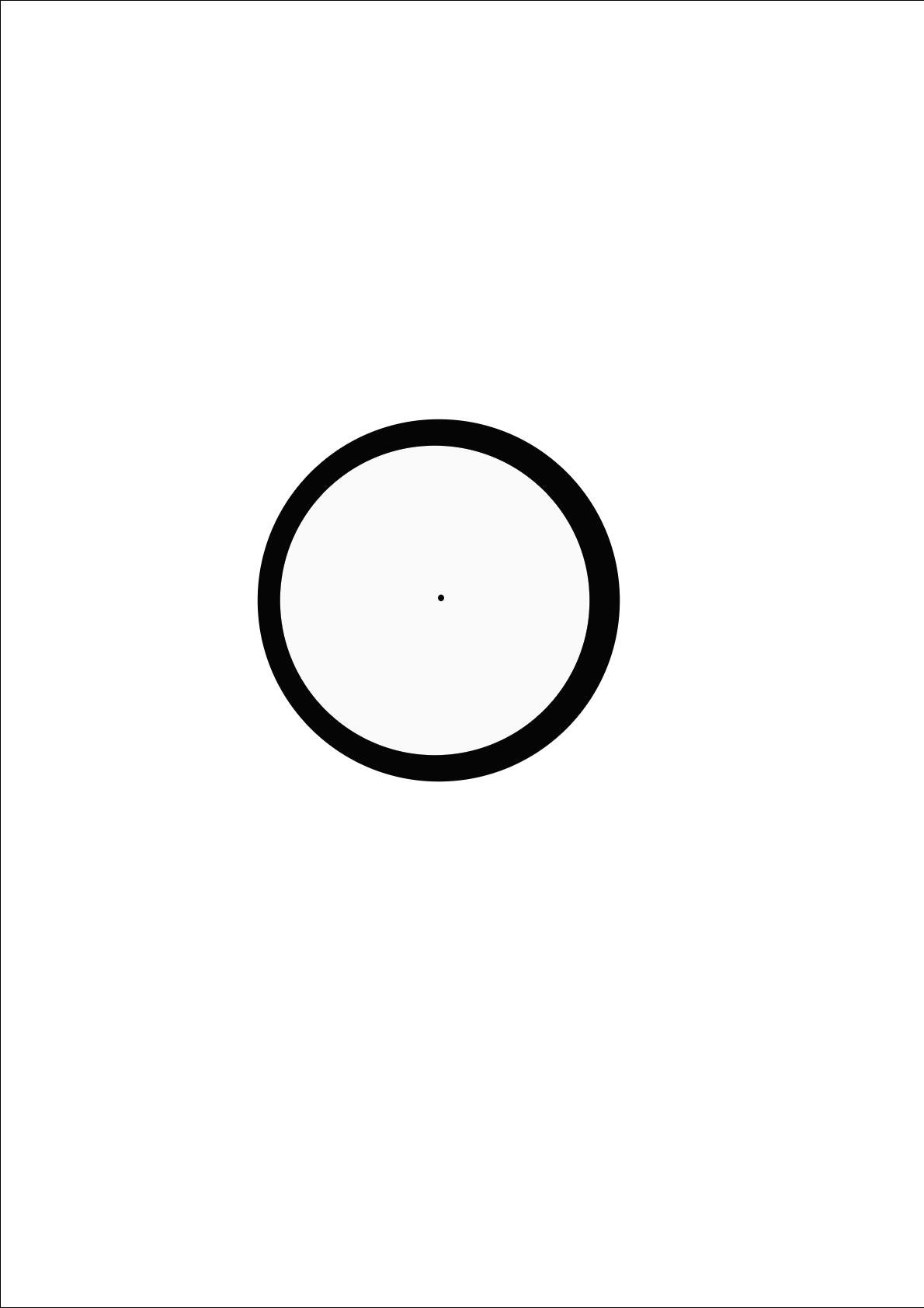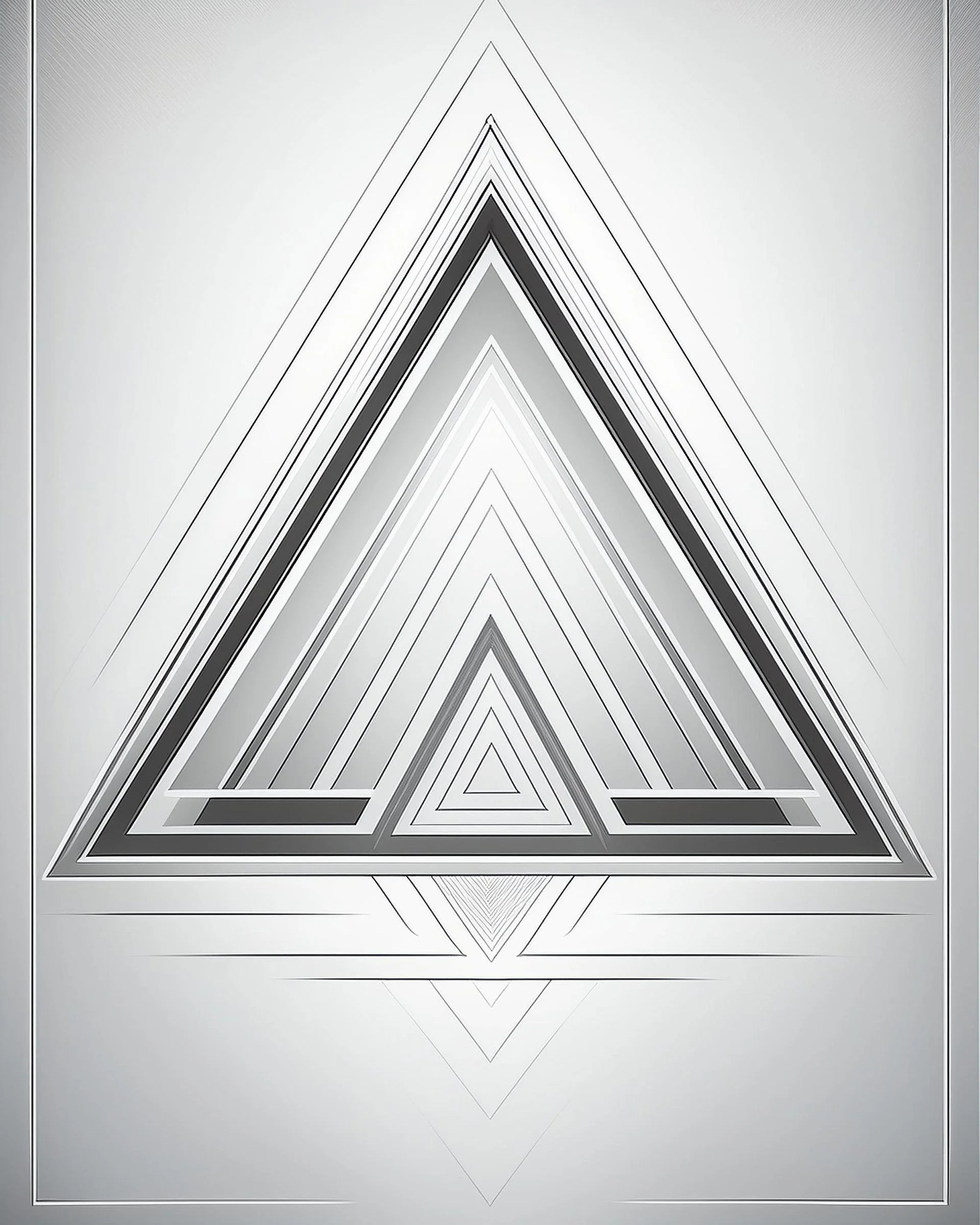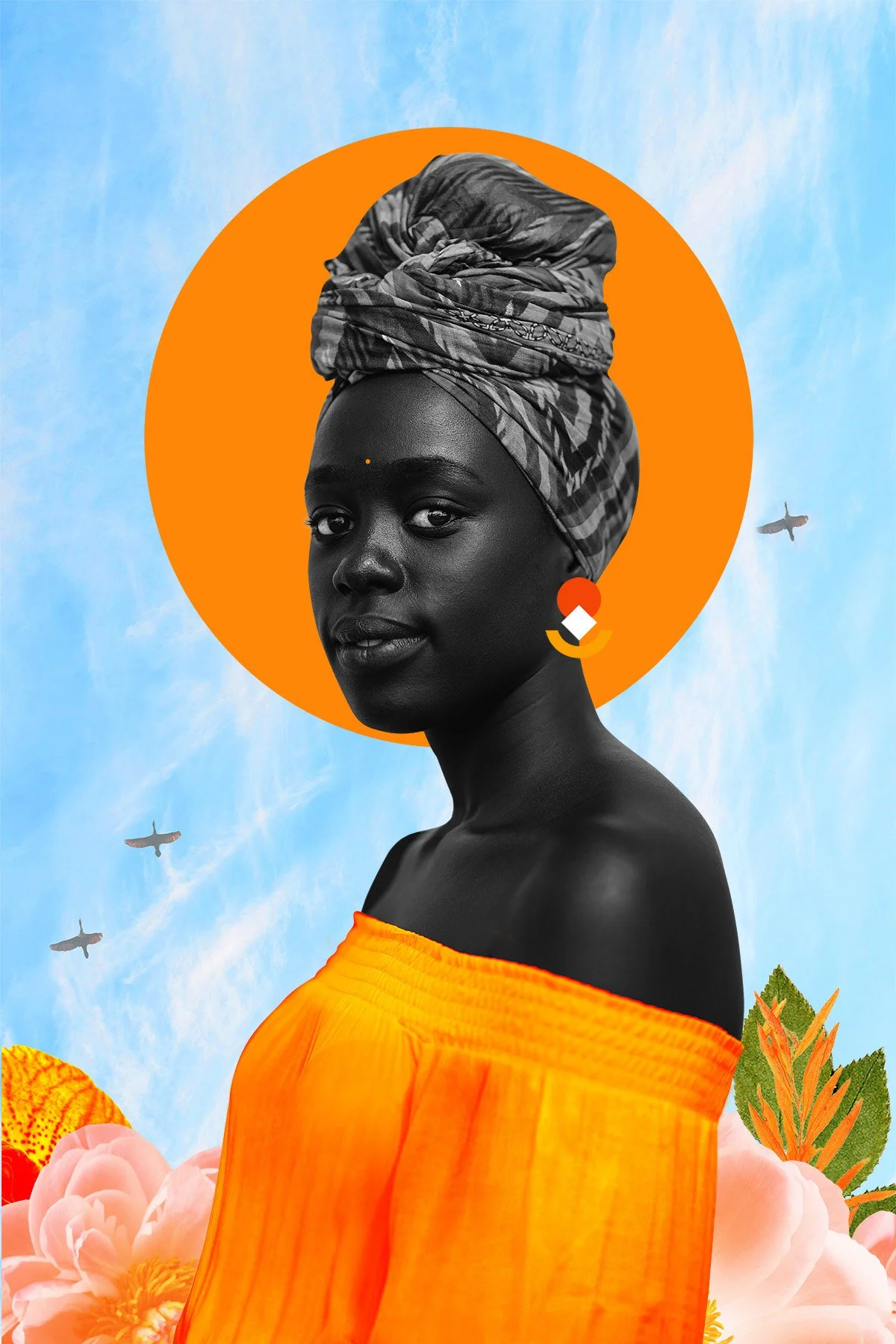These two works Before the Storm and Hustle and Bustle stand as mirror reflections of human experience, capturing the paradoxical stillness within chaos and the chaos within stillness. Though rendered in different mediums and moods, they both confront a universal truth: that beneath the surface of everyday life lies a quiet reckoning. Before the Storm lingers in a suspended breath, drawing us into the haunting calm that precedes upheaval. It is a meditation on anticipation, vulnerability, and the raw strength of the human spirit poised at the edge of transformation. The work does not show the storm itself it shows us the moment we prepare for it, spiritually and emotionally, reminding us that in stillness there is power, and in surrender, resilience. In contrast, Hustle and Bustle exposes the storm already underway—one that is invisible, internal, and continuous. Here, movement is relentless but hollow, a blur of routine and repetition. The work captures the cost of modern speed: disconnection, numbness, and the silent erosion of presence. It challenges us to ask what we’ve sacrificed in the name of productivity, and whether life, in its truest form, is happening somewhere just beyond the frame. Together, these pieces explore the thresholds we inhabit before collapse, within routine, beyond awakening. They ask not what we are running from or waiting for, but rather who we become in the in-between. In doing so, they offer a quiet, urgent invitation: to pause, to see, and to feel again.
BEFORE THE STORM
Title: BEFORE THE STORM
Medium: Archival Pigment Print
Dimensions: 24”x24”
1/1
Before the Storm is a hauntingly evocative art piece that captures the moment of perfect stillness just before chaos unfolds. Dark clouds gather ominously at the edges of the canvas, itching forward like a silent, creeping force, yet they hold back, hesitating, as if the storm itself is aware of the weight of what is to come. The water below is unnaturally calm, its surface undisturbed, mirroring the charged silence in the air. This is not peace it is the pause before eruption, a sacred, suspended moment where time holds its breath. At the center stands a statue, carved with raw emotion, arms reaching upward as if yearning to defy the chaos, to rise above what is inevitable. The statue embodies human resilience the eternal struggle to confront and survive whatever storm may come. It speaks to our instinct to persevere, to move forward even when surrounded by turmoil. Yet within the eye of the storm, there is no motion, no fury only stillness. And it is in this quiet core, this serene contradiction, that the piece reveals its truth: that even amid the threat of destruction, there is profound beauty. The calm before the storm becomes a metaphor for those rare, lucid moments in life where everything pauses where we see clearly, feel deeply, and prepare silently. But the piece also hints at what follows. After the storm, life transforms. Flowers bloom, the air clears, the world feels washed and renewed, and the sun returns with a brilliance that had been forgotten. Just as nature revives, so do we. The storms in our lives, though fierce, are necessary they cleanse, they challenge, they break what must be broken so that something truer can emerge. Through them, we are remade. What is lost may not be forgotten, but what is gained is the version of ourselves we were always meant to become. The storm, then, is not just destruction it is divine transformation, a painful grace, the hand of the creator shaping us through wind and rain. Storms are not the end; they are the beginning of growth, of clarity, and of a deeper, more radiant beauty.
HUSTLE AND BUSTLE
Title: HUSTLE AND BUSTLE
Medium: Archival Pigment Print
Dimensions: 24”x24”
1/1
“Hustle and Bustle” is a photographic meditation on the rhythm and rupture of modern life. Set in the heart of a downtown cityscape, the image captures more than just motion; it reveals the monotony within movement, the silence inside noise. At first glance, we see the predictable chaos of a weekday afternoon: cars in motion, a bus stationed to scoop up its passengers, figures clustered at a stop still yet tense, waiting, anticipating. Behind them, skyscrapers stretch skyward, monuments to ambition and exhaustion. In the far corner, a dark cloud creeps in, barely noticed, echoing the quiet heaviness that hangs over the scene.
This is not just a photograph of a place it’s a portrait of a condition. The subjects here are not individuals but roles: the worker, the student, the commuter. Everyone has a destination, but no one is arriving. There is no pause, no observation, no breath. The camera stands still even as everything else races past it. Time folds into routine: work, home, work, home a hypnotic chant that carries people through decades. And one day, when the chant grows faint and the legs slow, they look up and realize the world has already passed by. The dream they postponed to live, to see, to feel has dissolved into the smog of lost time.
The image questions whether this truly constitutes life, or merely the maintenance of existence. In its looping rhythm, the 21st century has traded vitality for productivity. The downtown bustle becomes not a sign of prosperity, but a symbol of detachment from nature, from wonder, from one another. “Hustle and Bustle” invites viewers to pause, to feel the weight of repetition, and to reconsider what it means to be alive in an age where everything moves except us.
Be in Infinity, Grounding in the Void with the Builder of Light
Welcome to Be in infinity, grounding in the void with the builder of light, a body of work that invites you to move beyond ordinary perception and engage with the profound interplay of existence, connection, and creation. These pieces reveals infinity not as distant or abstract, but as a living force woven into everything around and within us a boundless source from which all emerges and to which all returns. It challenges us to find stability not in rigid structures, but by grounding ourselves in the expansive void a paradoxical space of emptiness that anchors and sustains. Here, true illumination comes not from a singular, overpowering source, but from the subtle light that arises in shadow, in nuance, and within ourselves. This body of work calls for a deeper presence an invitation to feel the infinite within, to root yourself in its vastness, and to discover a more authentic, multifaceted light that speaks to your own inner truth. We invite you to explore this journey and uncover the new perspectives it reveals.
Title: BE
Medium: oil on canvas
Dimensions: 70”X70”
1/1
Some may see a dot on paper. Others may say it’s unclear, incomplete, or even unartistic. But BE defies those definitions. It resists containment within the narrow frameworks of judgment, categorization, or interpretation. It is not an attempt at beauty, a display of skill, or a narrative frozen in pigment and line. BE does not ask to be understood. It simply exists as pure being.
BE is an act of resistance against the compulsion to explain. It is a meditation on existence itself silent, eternal, unchanging. A single mark. A drop. But within this drop lies the echo of all things. It transcends space and time. It is timeless, for it does not rely on context or culture or comprehension to validate its presence. Its only purpose is to exist, to be seen, and to vanish when unobserved much like our own fleeting lives in the vastness of the universe.
When you look at BE, it becomes. When you look away, it ceases not because it is gone, but because your awareness of it dissolves. It does not ask to be remembered, for memory is too narrow to contain its essence. It is the dot or the “dop” that mirrors our place in the cosmic order. A dot on an infinite canvas, seemingly insignificant, yet holding within it the entirety of existence. That drop is us. That drop is everything.
The simplicity of the mark is deceptive. It holds within it all that has been and all that will be not in a way that can be decoded, but in a way that must simply be felt. It carries knowledge beyond comprehension, power older than thought. To attempt to understand it is to miss the point. When one believes they have unraveled its meaning, that belief is the first sign that they have not.
BE is not a riddle. It is not a metaphor. It is not even a statement. It is the quiet presence of existence itself. It does not offer comfort or clarity. It offers presence. It invites you to let go of meaning, of certainty, of ego and simply observe. Observe the moment. Observe your response. Observe the vast stillness behind thought. Then let it be.
The greatness of BE lies not in its visual form but in its spiritual stillness. It is a mirror for the observer silent and still, yet infinitely deep. It reflects not what we see, but what we bring to the act of seeing. And beyond that, it reflects something even deeper the quiet presence of the creator, the unspoken source from which all creation flows. Let it be.
BE
BE IN INFINITY
Title: BE IN INFINITY
Medium: oil on canvas
Dimensions: 70”X70”
1/1
To be in infinity is to exist in the now. The wheel, a sacred circle in motion, embodies the eternal dance of existence symbol revered across cultures and spiritual traditions. Its unending loop mirrors the cycle of life, death, and rebirth, reminding us of the interconnectedness of all beings and the perpetual flow of time. At the heart of this wheel lies a singular dot, representing the divine spark within each of usthe point where the Creator and creation converge. This central point signifies our individual essence, the soul’s journey through the myriad of experiences of life. As the wheel turns, it reflects the stages of human existence: birth, growth, decay, and renewal. This continuous rotation is not merely a passage through time but a spiritual odyssey, guiding us toward enlightenment and unity with the divine . The wheel’s motion illustrates the concept of karma, where every action influences the next, weaving a tapestry of cause and effect that shapes our destiny . In this sacred geometry, the circle symbolizes wholeness and infinity, while the dot signifies the origin of all creation, the divine source from which all life emanates. Together, they encapsulate the profound relationship between the finite and the infinite, the temporal and the eternal. Embracing this symbolism invites us to reflect on our place within the cosmos, to recognize the divine within ourselves, and to understand that life’s journey is a continuous cycle of transformation and spiritual growth.
THE GROUNDING VOID
Title: THE GROUNDING VOID
Medium: oil on canvas
Dimensions: 70”X70”
1/1
In the center of an untouched white canvas, a Black square rests not loud, not pleading, but resolute. It does not scream for attention; it holds it. Amid the vastness of whiteness symbol of potential, of the unknown, of mind unclouded the Black square becomes an anchor, a silent truth, a presence that cannot be denied. It is the seed of gravity in a sky of light.
Artistically, it defies embellishment. It is stark, stripped of all excess, the way a soul might appear when no longer pretending. There is no flourish, no illusion of motion, no appeal to decoration. Just the bold simplicity of being. Black totality and absorption draws everything in: light, thought, time. And yet, it gives back in reflection, in contemplation. It is both the question and the answer.
Spiritually, the Black square is not emptiness, but fullness concentrated like the center of the self. A still point amidst chaos. It is the womb of possibility, the fertile dark where new light is born. The longer you gaze into it, the more it gazes back. It reminds you that clarity doesn’t always come from brightness. Sometimes, it emerges from shadow, from silence, from being still long enough to feel the weight of your own existence.
This square keeps you. It does not let you drift too far into the ether. It grounds you. It tells you: “Here you are.” It speaks without words, reminding you that in a world teeming with color, movement, and distraction, you still have a center. And it is whole. And it is Black. And it is sacred.
The Builder
Medium: oil on canvas
Dimensions: 70”X70”
1/1
Imagine a single, perfectly symmetrical black form at the absolute heart of a pristine white page. It's tiny, almost a speck, yet it holds an immense visual weight, a pinprick of focused darkness against the infinite expanse of light. Spiritually, this initial, small form represents the seed of creation, the singular point of origin from which all things emerge. It's the unmanifest, pure potential, a silent "OM" whispered into the void.
As this triangle begins its outward journey, it doesn't just grow; it multiplies and expands, each new form echoing the first. From that central point, new triangles emerge, slightly larger, slightly less intense in their blackness, creating concentric layers of form. It's as if a ripple of geometric energy is radiating from the core. Artistically, the transition from small to large isn't a mere scaling up; it's a journey of increasing complexity and subtle shifts in value. The deepest black of the central triangle gradually softens to charcoal, then to a rich grey, and eventually to a pale, ethereal shade that barely distinguishes itself from the white of the page. This gradient isn't uniform; it's a natural, almost organic progression, like the rings of a tree or the expanding ripples in a still pond.
Spiritually, this outward expansion signifies the unfolding of existence. Each successive triangle represents a new layer of reality, a new dimension of experience. The initial, intense blackness of the core might be the divine, the absolute truth, while the lighter, more diffuse triangles represent the myriad forms and illusions of the material world. Yet, even in their difference, they remain intrinsically connected to their origin, each one a reflection of the first. The shift from a singular, focused point to a radiating pattern evokes a sense of manifestation and diversity arising from unity. The increasing size symbolizes growth, evolution, and the boundless nature of the spirit. The interplay of black and white throughout this expansion is a powerful visual metaphor for the duality of existence: light and shadow, form and void, creation and dissolution. Each reinforces the other, creating a dynamic balance that is both aesthetically captivating and profoundly symbolic. The entire page becomes a silent testament to the journey from the microcosm to the macrocosm, from the ineffable source to the manifest universe, all held within the elegant simplicity of a spreading form.
LIGHT
Medium: oil on canvas
Dimensions: 70”X70”
1/1
In this work, I explore the intersection of the physical and the divine through a visual language of colorful triangles, arranged in ascending size across the canvas from the smallest, nearly imperceptible forms to the bold and expansive. Each triangle acts as a vessel of both weight and lightness, grounding and transcendence.
The triangle is a sacred shape anchored in earth yet pointing to the heavens. It holds an ancient symbolism found in spiritual traditions, architecture, and nature. By repeating this form in vibrant, layered color, I aim to evoke both the material presence of paint and shape, and the immaterial sense of energy, movement, and transcendence.
The gradual increase in size is a deliberate metaphor for ascent: the journey from the finite body to the infinite spirit, from complexity to clarity. Each triangle exists in its own physical integrity dense, textured, and full of pigment yet they also appear to rise, almost levitate, across the surface. This duality is at the core of the work: the tension between what is grounded and what reaches beyond.
Color plays an essential role in expressing the divine. I use a vibrant palette sometimes harmonious, sometimes in contrast to evoke emotion and spiritual resonance. The colors are not just decorative; they are elemental. They pulse with life, interacting with each triangle’s size and position to suggest energy moving upward, outward, and inward all at once.
This work is as much about presence as it is about progression. The viewer is invited to contemplate the scale of their own being physical and spiritual through these forms. It is a meditation on how simple shapes, repeated and transformed, can hold space for something larger than themselves: the sacred within the structure, the divine within the everyday.
The Human Condition
Welcome to A Glimpse into the Human Condition, an exhibition that invites viewers to engage deeply with the quiet yet powerful narratives embedded in childhood, identity, and the evolving self. Through the lens of these evocative portraits, we witness moments that transcend time and circumstance where innocence meets introspection, where stillness hums with meaning, and where identity unfolds with quiet resilience. Each image offers more than representation; it offers revelation a window into what it means to think, to wait, to reckon, and to grow. Our journey begins with The Thickener, where the contemplative gaze of a young African American boy echoes Rodin’s iconic sculpture but with a disarming authenticity. His expression, small fist resting beneath his chin, speaks not only to curiosity but to the profound mystery of thought emerging in its earliest form. This is not mere mimicry; it is instinct. A visual meditation on youth and the power of imagination. In The Wait, time slows. A boy sits alone, suspended in stillness on weatherworn steps, while a mirror in the background bursts with unexpected color. He does not look into it but we do. The contrast is jarring and symbolic, inviting questions about potential, transformation, and the futures we cannot yet see. His waiting is quiet but charged, reminding us that all beginnings are born in stillness. Tension brings us into the nuanced world of Black girlhood, where two girls sit poised and solemn in a space alive with historical and cultural symbolism. Between them, an ancestral sculpture watches silently, anchoring them in a lineage both proud and complex. The composition, painterly and restrained, offers no easy resolution. Instead, it presents identity as lived tension a negotiation of presence, expectation, and becoming. Lastly, Conflict portrays an American Muslim girl at a crossroads of culture and self-discovery. Caught between the norms of American girlhood and the sacred traditions of her faith, she stands not divided but defined by both. Her hijab and hoodie, side by side, symbolize a beautifully complex duality. In her quiet strength lies a universal truth: we are shaped not in spite of our contradictions, but because of them. Together, these photographs form a poetic meditation on the human condition revealing how even the smallest moments in a child’s life carry immense weight. These are stories of introspection, resilience, and the courage to be seen. We invite you to enter these worlds, not just to look but to feel, to question, and to remember what it means to become.
THE THINKER
Title: THE THINKER
Medium: Archival Pigment Print
Dimensions: [24x24]
The photograph is a powerful extreme close-up of a young African American boy, no older than four, his delicate features captured with intimate clarity. His skin glows with the soft texture of youth, and his expression carries an uncanny gravity. His small hand, curled into a fist, rests gently under his chin in a pose reminiscent of Rodin’s “The Thinker.” But unlike the statue, this boy’s contemplation feels startlingly real raw, unfiltered, and deeply human.
His large, thoughtful eyes gaze just past the camera’s lens, as though he’s staring out at something vast and invisible a world beyond his years. There’s a stillness to the image, a quiet tension that invites the viewer to pause. The background is blurred, nearly absent, putting all focus on the rich detail of his face: the furrowed brow, the almost imperceptible parting of his lips, the slight tilt of his head. It’s a pose that suggests not imitation, but instinct.
In this moment, he could be pondering anything from why the sky is blue to why the world is sometimes unkind. The weight of his gaze suggests something deeper a child absorbing, questioning, and forming his own thoughts about a world he’s just begun to discover. There is poetry in this still frame, an echo of every soul that has ever paused to wonder. It’s not just a portrait; it’s a meditation on the mystery of thought, the purity of innocence, and the beauty of curiosity.
WAITING
Title: WAITING
Medium: Archival Pigment Print
Dimensions: [24x24]
waiting, a young boy sits alone on the weatherworn steps, hands on knees, his gaze lost in the gravity of thought. The world around him is rendered in black and white shades of silence, of stillness, of time paused. His presence is unhurried, like stone carved by years of wind, unmoved yet aware. There is a hush to the moment, a suspended breath in the hush of waiting.
Behind him, in the far corner, a mirror leans crooked against the wall. Unlike everything else, the mirror bleeds with color. Crimson, teal, golden strands swirl inside it like a painted storm. It does not reflect the grayscale scene it dares to reflect something else entirely: the future, perhaps. Or possibility. Or a self not yet stepped into. It is a portal disguised as glass, a whisper of what may come. He does not look at it.
He simply waits. Waits as we all do not for a bus, not for the turning of a clock, but for the intangible. Waiting for purpose. Waiting for someone. Waiting for that first breath of movement in a journey yet unnamed. The steps beneath him are solid, but the world behind his eyes is fluid and restless. His stillness is not idleness; it is a gathering of strength. Is he waiting for the future to find him, or is he summoning the courage to step into it?
The mirror gleams behind him, unnoticed yet loud in its color. It tells a truth he cannot yet hear: that there is light after this grey. That we do not wait forever. That all waiting is, in its own way, a beginning.
He is every child. He is every dream. He is each of us paused at the edge of our own reflection, wondering what lies just beyond the frame.
CONFLICT
Title: CONFLICT
Medium: Archival Pigment Print
Dimensions: [24x24]
In this powerful and evocative artistic photograph, an 8-year-old American Muslim girl stands still, yet speaks volumes. She is framed by shadows and light, a visual metaphor for the complex duality of her identity. Raised in the heart of an American inner city, her world is shaped by both struggle and resilience. Behind her soft eyes lies a restless mind filled with questions too big for her age, yet too important to ignore. What is expected of her? From herself? From her family? From the world around her? These questions swirl in her thoughts as she dreams of walking across a high school graduation stage and one day stepping onto a college campus, breaking barriers not just for herself, but for the many girls who feel caught in the same quiet storm.
She is as intelligent as a sugar bee quick, curious, and full of life, always working to understand the world she’s been born into. But even intelligence can’t shield her from the weight of identity. She finds herself caught in a subtle but constant conflict: does she blend into the backdrop of American childhood, with its pop culture, peer pressure, and longing to “fit in”? Or does she submit to the expectations of her Islamic upbringing, filled with structure, values, and sacred tradition? To her young heart, it sometimes feels like an either/or. And yet, this photograph captures a deeper truth slowly blooming within her: she doesn’t have to choose. She is not one or the other she is both. American and Muslim. Modern and traditional. Bold and gentle.
The hijab wrapped around her head is more than fabric it is the thread of her faith, stitched with hope, pride, and the dreams of generations. It symbolizes her devotion, her connection to something eternal. The hoodie she wears over it speaks just as loudly. It wraps her in familiarity, an armor against stares and whispers, and a symbol of her desire to simply be another American kid trying to make sense of the world. In this image, the contrast doesn’t divide her it defines her. She is misunderstood in her conflict, but not broken by it. In fact, the very tension she feels is the fire that is shaping her spirit.
Conflict, she is slowly learning, is not the enemy it is the forge. It transforms us, forces us to question, to adapt, to rise. It makes us who we are, and who we are becoming. In her gaze both soft and strong there is no sign of surrender. There is only growth, quiet courage, and the beauty of a girl learning to embrace every part of herself. This photograph doesn’t just capture a child. It captures a story of identity, belonging, and becoming. She is beautiful, unique, and intelligent and most importantly, she is enough just as she is.
TENSION
Title: Tension
Medium: Archival Pigment Print
Dimensions: [24x24]
In Tension, the photographer delivers a resonant visual meditation on the layered experience of Black girlhood. The image captures two young girls in a carefully arranged interior space seated, still, and unsmiling. There is no overt action, yet the atmosphere hums with emotional charge. The girls’ posture, gaze, and distance from one another evoke more than familial or interpersonal ambiguity; they signal the quiet negotiations of identity, history, and expectation.
The composition is deliberate. A West African sculpture sits between or near the girls neither background nor centerpiece, but an ever-present witness. It serves as both cultural marker and symbolic tether, grounding the photograph in diasporic lineage. This object, carved and ancestral, exists in contrast to the smooth vulnerability of the girls’ skin, inviting a layered reading: of time, of inheritance, and of resistance.
Lighting in the image is soft yet sculptural. Gentle shadows caress the girls’ faces and garments, imbuing them with the solemnity of oil-painted portraits. This painterly aesthetic draws comparison to 17th-century Dutch and Flemish portraiture compositions that often suggested status, restraint, and introspection. Yet here, such visual language is subverted and recontextualized, recasting Black girls as both subjects and symbols of quiet fortitude.
What makes Tension profoundly compelling is its refusal to resolve. The viewer is left suspended caught between the girls’ stoicism and their youth, between cultural weight and personal agency, between tenderness and restraint. It is this stillness that radiates most powerfully. The tension is not simply between the figures, but within the entire frame: between presence and performance, inheritance and becoming. More than a portrait, Tension is a poetic tableau a visual reckoning with the unspeakable pressures and quiet resistances carried in the bodies of Black girls.
Title: GOD
Medium: Archival Pigment Print
Dimensions: [24x24]
In this photograph, titled God, I present a vision that reimagines divinity through the lens of Black womanhood. At the center stands a dark-skinned Black woman, her hair covered, enveloped in a radiant orange dress that flows like sacred fabric. Behind her, an orange halo glows, echoing the iconography of saints and deities across cultures. The backdrop features a vast blue sky where birds soar freely, and vibrant flowers bloom around her, symbolizing life, freedom, and the interconnectedness of all beings.
This image challenges traditional depictions of God as a distant, patriarchal figure. Instead, it offers a portrayal rooted in the fundamental essence of creation the Black woman as the giver of life, the birthplace of humanity. This perspective aligns with the understanding that the origins of human life trace back to Africa, acknowledging the Black woman as the primal mother of all.
The photograph also invites contemplation on the question: If you were god who or what would you be? In this context, the Black woman embodies the eternal presence of the divine, suggesting that even in absence, her essence permeates existence. The orange halo signifies enlightenment and spiritual awakening, while the surrounding birds and flowers represent the soul’s journey and the blossoming of consciousness.
By presenting God as a Black woman, this work seeks to honor and elevate the often-overlooked divinity inherent in Black femininity. It is a visual affirmation that the sacred resides within those historically marginalized, urging viewers to recognize and revere the profound spiritual power of Black women.
This piece aligns with the work of artists like Harmonia Rosales, who reimagine classical art to center Black female figures, challenging Eurocentric narratives and celebrating Afrocentric spirituality. Similarly, portray of Black women as spiritual avatars resonate with the themes explored in this photograph, emphasizing the sacredness and resilience of Black womanhood.
Ultimately, God is not just a photograph; it is a statement a call to acknowledge the divine in forms that have long been overlooked. It is a testament to the enduring spirit and creative force of Black women, who continue to shape and nurture the world.
